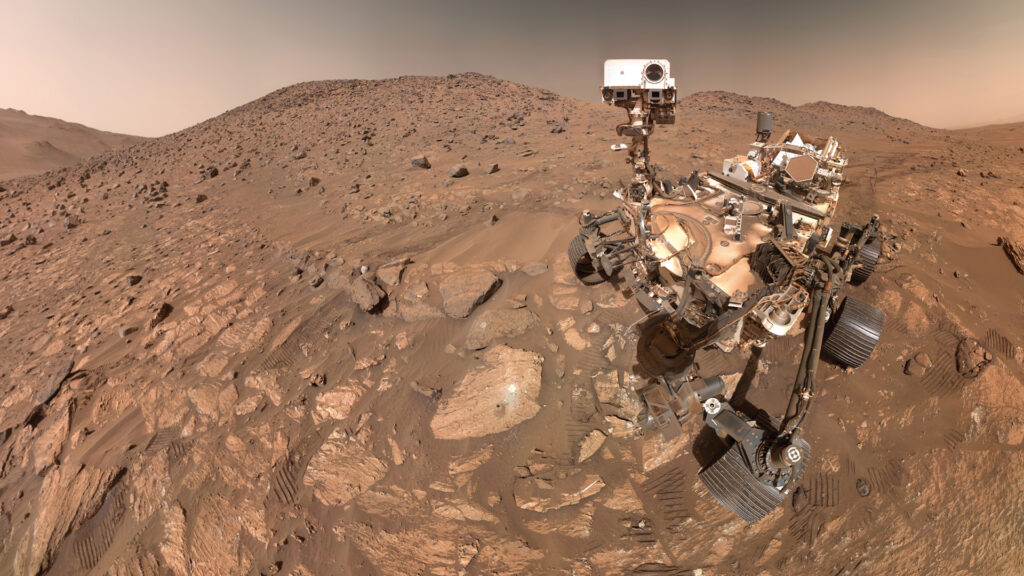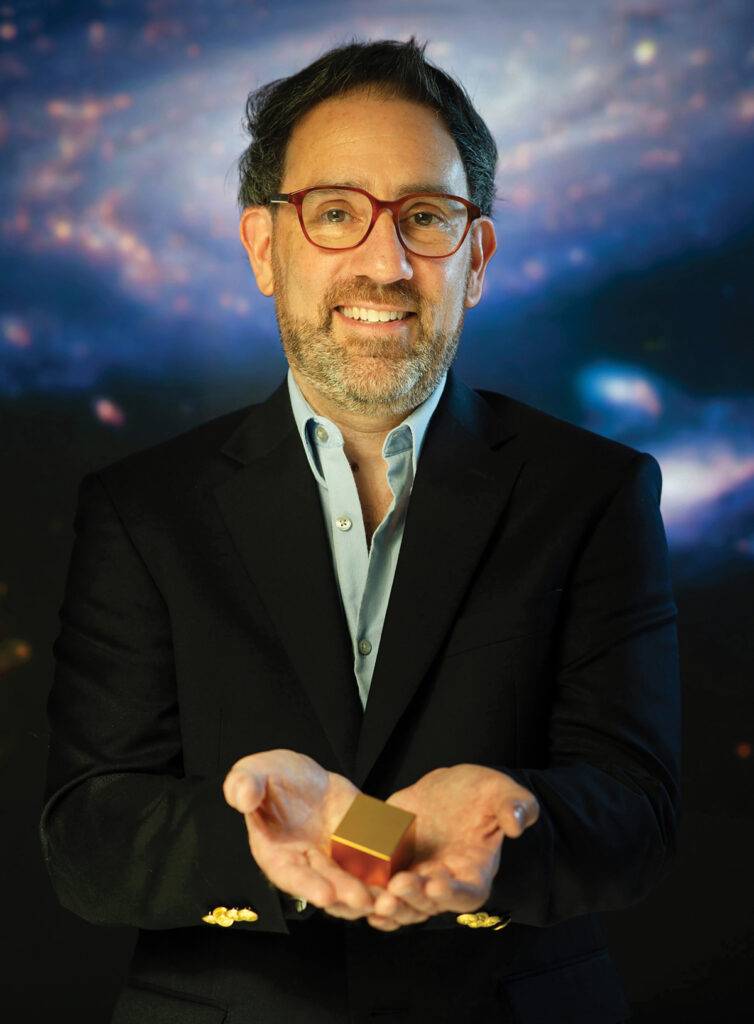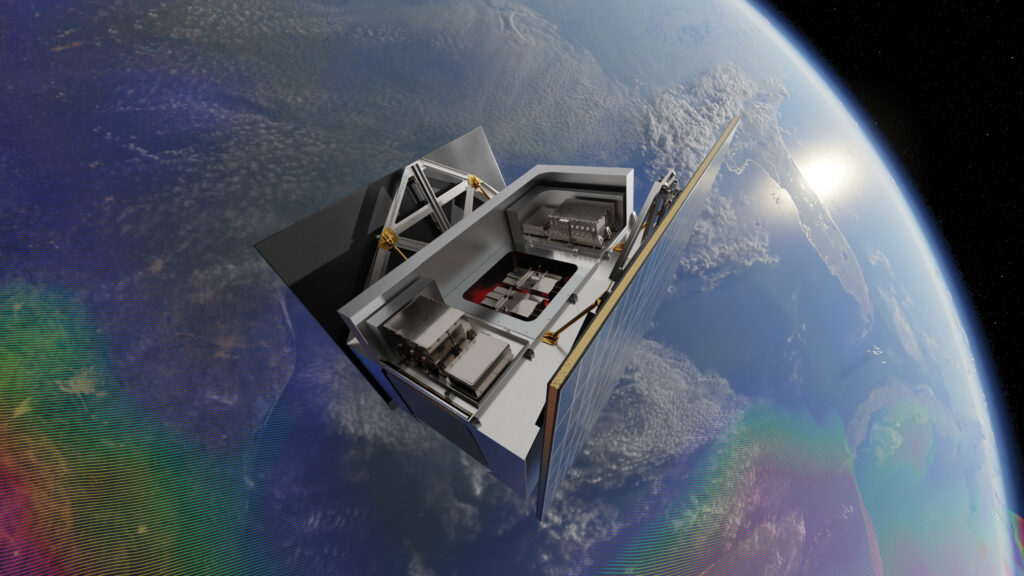John Conklin and Amy Williams both faced pivotal career moments as young doctoral students.
Conklin knew exactly what he wanted: A chance to work on gravitational waves that began rippling across the universe when black holes collided billions of years ago. More than two decades later, Conklin still speaks avidly about precisely measuring the ancient, unseeable forces that shaped the universe.
Williams had a burgeoning passion for astrobiology and geobiology research, pivoting from earth science as her academic career progressed. In early 2009, her research options were starkly different: Live in Antarctica for three months and dive in frigid lakes to study microbial growth. Or she could work on Mars research.
Those choices ultimately led Conklin and Williams to the University of Florida. Their research work — vastly divergent but crucial to understanding the origins of the universe and its biology — is now being further harnessed by UF’s Astraeus Space Institute. The institute was created earlier this year by former UF President Ben Sasse to spark intensive scientific collaboration and innovative space research.
For Williams, the choice of research paths came from Dawn Sumner, a geobiologist at the University of California, Davis and co-investigator on the Mars rover Curiosity.
It didn’t take Williams long to decide.

“I don’t like the cold and I don’t actually have to fly to Mars,” says Williams, a UF astrobiologist and associate professor of geology.
That decision paid off almost immediately, giving her a role on the NASA team that uses Curiosity to study rock layers and search for habitable environments on Mars. Since 2020, she’s also been a participating scientist for the Perseverance rover — one of just a handful of experts to fill that role on both Mars missions.
Perseverance has spent more than three years combing Jezero crater, a site chosen because it once held a large river delta that flowed into an ancient lake. The rovers’ work is essential to two larger, elemental questions being pursued by Williams: Could there have been past life on Mars? Is there life there today, perhaps somewhere underground?
Sites on Mars that have water, organic carbon and minerals are fertile ground for seeking evidence of past life. Perseverance is busy drilling samples that will provide important context about conditions on Mars that gave rise to particular types of rocks.
“We’re actually going to be able to determine when water was flowing on the surface of Mars — something no one knows with precision right now,” Williams says.
Perseverance is carrying SHERLOC, a NASA-built instrument that detects minerals and organic matter in Jezero crater’s rocks. It uses cameras, a spectrometer and a laser to scan for minerals and compounds that may hold evidence of past microbial life. In 2022, a Perseverance team that includes Williams analyzed and stored rock samples that were altered by water, giving further evidence of a wet past on Mars. That same year, the rover found signs of organic molecules. Whether those molecules came from geological processes or ancient life hasn’t been determined.

Rocks on the red planet may also hold other tantalizing clues, Williams says. Bacteria and many other microbes can use chemical energy from rocks. An electron from one of those rocks could have been enough to spark life-giving metabolism in a microbe.
“That’s why we look for organic carbon, water and minerals,” Williams says. “They’re the requirements for life as we know it.”
Combing Mars rocks for signs of extinct life is exceptionally painstaking. Instead of seashells or bones, Williams and her collaborators search for fossilized bacteria — at best a thin mat of microbes embedded in rock.
“We don’t have any evidence for life right now but we have evidence for where life would want to live if it had been there,” Williams says. “My hope would be to find signs of microbial life, something akin to bacteria on Earth.”
Listening To The Universe
While Williams focuses on Mars, Conklin concentrates on developing technology to detect the faint hum of low-frequency gravitational waves. The waves are a time capsule of sorts, giving scientists unique insights into the ancient, violent collisions of stars and black holes that have helped to define the universe.
For Conklin, that means never forgetting when he fell in love with LISA.
In the mid-2000s, Conklin was pursuing a doctoral degree at Stanford University. His focus was on Gravity Probe B, a satellite-based NASA mission measuring how space and time are “warped” by the Earth’s presence. Meanwhile, other Stanford scientists were working on the Laser Interferometer Space Antenna. LISA’s trio of satellites will one day trail in the Earth’s wake as it circles the sun, measuring gravitational waves that reveal the origins of the universe with unprecedented range and clarity.
Since the two Stanford projects had some overlapping technology, Conklin got to learn more about LISA — and he was hooked.
“I just fell in love with the mission — not only the science, which I think is amazing — but the technology and engineering of it,” says Conklin, a mechanical and aerospace engineering professor.

Almost 20 years later, LISA is still a big part of Conklin’s work. The European Space Agency, with major contributions from NASA, plans to launch LISA in 2035, when its trio of cartwheeling, synchronized spacecraft will follow Earth’s orbit by tens of millions of miles. Its job: Detect the subtle frequency shifts that reveal how galaxies form and black holes merge. From its position in space, LISA will detect a different range of gravitational waves than terrestrial equipment. It’s designed to capture the slower, lower frequency gravitational waves that elude current machinery.
“If LISA operates successfully, we’ll basically be listening to the whole universe at once,” Conklin says.
Conklin’s work involves a key piece of equipment: Without it, LISA goes deaf or doesn’t function optimally.
At about 10 pounds and the size of a shoebox, Conklin’s charge management device, or CMD, houses ultraviolet LEDs and fiber optic cables that deliver light to a test-mass sensor. The CMD blocks disruptive electrical charges on free-floating gold and platinum alloy cubes inside LISA, assuring it can detect gravitational waves.
For Conklin, building and testing eight bespoke CMDs — six for space flight and two spares — means focusing on every last detail. To function properly, LISA’s gold-platinum test masses must operate free of any external forces. That means finding a way to electrically ground the test masses without touching them. On Earth, grounding would be as simple as attaching a wire. In space, even the smallest wire would exert undesired force on LISA’s test masses. Conklin’s solution is to use ultraviolet light for electrical grounding.
His team’s devices also have to meet many other challenges. The CMDs must be optimally sized for spacecraft but durable enough to withstand a long mission life. Their ultraviolet LEDs have only existed for about 20 years and haven’t yet been certified for space flight.
Conklin’s lab is a veritable torture chamber for his CMD. A thermal vacuum chamber simulates conditions in space. His lab has bombarded the device with gamma rays and proton beams. It’s been exposed to heat, chilled to at least -22 degrees Fahrenheit and shaken to simulate the forces of a rocket launch.
So far, so good.
“We have shown they’re inherently radiation hard and capable of surviving other conditions,” Conklin says.
NASA will do a detailed review of the device’s design and test results this fall — a determination that the prototype works as intended. Conklin’s current $12.6 million NASA contract for technology and prototype development runs through 2025. At the agency’s discretion, a flight contract could begin in 2025 or 2026, Conklin says.
Revolutionary Knowledge
Using spacecraft to detect the gravitational waves that ripple through space will give scientists unprecedented insights into universe-shaping events and the number of black holes, Conklin noted.
“It tells us about galaxy formation because we’re pretty confident that every galaxy, including our own, has a black hole. It’s telling us how the universe came to be the way it is,” Conklin said.
Still, not all of Conklin’s work is focused on the heavens. It turns out the same type of instruments that focus on deep space can also be aimed at Earth. Spacecraft that are trained on the Earth’s gravitational field can reveal changes in ice levels at the poles. By measuring gravity, scientists can tell the volume of ice that has melted and flowed into an ocean. That, Conklin says, is far more valuable than a static image of an ice sheet. Likewise, a pair of spacecraft can be focused on water resources. A tiny wobble in the distance between the spacecraft is enough to determine water levels in Florida’s aquifers or California’s farm-rich Central Valley.
“It’s about climate change with the melting of the Arctic and Antarctic,” Conklin says. “But it can also tell us about drought conditions that are important for agriculture.”
Earlier this year, Conklin won a $12 million NASA grant to lead a team of UF researchers studying groundbreaking ways to detect changes in Earth’s structure. Sensors that measure minute gravitational changes from space will be used to monitor the movement of water, ice and the Earth’s tectonic plates.
Technology flying on the Gravitational Reference Advanced Technology Test In Space, or GRATTIS, is vital for assessing groundwater supplies, tracking droughts and understanding how sea levels are affected by melting ice sheets, according to Conklin.

Conklin will spend the next few years finalizing the sensor technology for GRATTIS and integrating it into the spacecraft. A SpaceX rocket is expected to carry the device into orbit around 2027. More broadly, Conklin says the Astraeus Space Institute will enhance UF’s space research by supporting faculty members’ pursuit of large space mission proposals to NASA and other federal agencies. UF also plans to form a space mission operations center that can operate rovers on Mars, handle experiments on the International Space Station and control free-flying spacecraft.
Conklin, an assistant director of the institute, says the chance to push the boundaries of space research is especially invigorating. Determined astrophysicists around the world are testing Albert Einstein’s theories to their limits. Other space scientists are harnessing technology to better track our changing planet.
“With this job, I’m always working and I’m always on vacation because I really can’t tell the difference between the two,” he says. “The technology that we use and develop is really cool but the science is also extremely important.”
From Mars To Earth
Someday, NASA and the European Space Agency hope to bring dozens of titanium tubes filled with Mars soil and rock-core samples to Earth. For the Mars Sample Return to happen, a vehicle that can launch from the red planet and connect to an orbiter is needed. NASA has begun seeking private proposals for the return trip after its own estimate stretched to $11 billion with a timeline of about 16 years.
Williams lights up at the prospect of analyzing Mars rocks on Earth. She likens the samples to a scientific jewelry box — small, precious and information-dense rocks that give important geologic nuances about the planet’s past.
UF Astrobiologist Amy Williams’ search for answers is terrestrially based. Through her work on two Mars rovers – NASA’s Curiosity and Perseverance, Williams is part of a team that combs the rocks of the red planet, looking for evidence of water and carbon, two key chemical ingredients for sustaining life.
A 2023 analysis of Perseverance rock samples by Williams and her colleagues suggested there may be a diverse pool of organic molecules among two rock formations in Jezero crater. It’s also possible the molecules were deposited by groundwater moving through the rocks billions of years ago.
Still, Perseverance’s instruments aren’t sophisticated enough to discern the exact origins of organic carbon on Mars. Bringing rock samples to Earth would vastly improve the accuracy and range of scientific testing that can be done, Williams says.
Terrestrial testing would help Williams and others to better pinpoint when water was flowing in Jezero crater. Right now, that time frame covers about 1 billion years — something that could be narrowed considerably with earthbound testing of Mars rocks.
“You’re getting a window into the infancy of a planet when you see rocks of that age that are no longer preserved in most places on Earth,” Williams says.
For Williams, decoding the geologic clues of Mars has also meant scouring parts of the earth. In 2021, she was the lead investigator on a UF-funded project that uses terrestrial sites to develop new technologies that better detect organic molecules on Mars.
Williams’ work has taken her to locations that mimic at least one environmental aspect of Mars. In Iceland, she is working to understand how certain organisms and their biosignatures respond to the repeated wet-dry cycles that once took place on Mars. Williams has also probed a Northern California mountain range, studying how microbes are preserved in the iron oxide minerals of an acidic, salty environment — as they might be on Mars.
From her roles with two Mars rovers, Williams can also testify to the power of collaboration. It’s why she sees the Astraeus Space Institute as a special opportunity to boost interactions between colleges and utilize UF’s engineering expertise to build equipment that helps to answer crucial scientific questions.
“The institute is going to provide a new venue for synergistic work. It presents opportunities to work with other experts across campus like nowhere else,” Williams says.
It’s that optimism — and a sense of wonder — that propels her after more than a decade of space research.
“I get to wake up every day and see brand-new pictures of Mars that no human has ever experienced,” Williams says. “Hopefully one day, astronauts will see Mars in person. Until then, knowing that I’m helping to discover something that’s never been broached by humanity is a really extraordinary motivator.”

Sources:
John Conklin
Mechanical and Aerospace Engineering
jwconklin@ufl.edu
Amy Williams
Associate Professor of Geological Sciences
amywilliams1@ufl.edu
Hear the Story
The audio version of this story is available on our YouTube.

